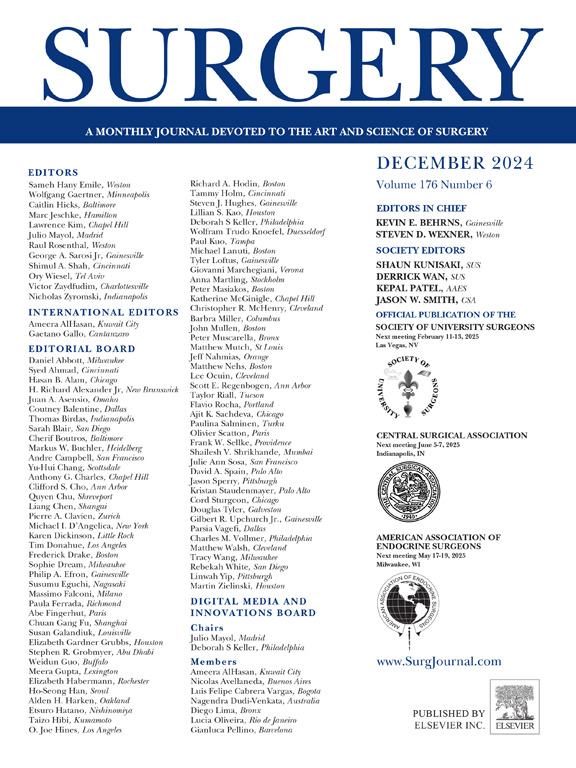多发性内分泌肿瘤2型人群嗜铬细胞瘤部分肾上腺切除术:是否需要重新考虑?
IF 2.7
2区 医学
Q1 SURGERY
引用次数: 0
摘要
肾切除术被认为是治疗多发性内分泌肿瘤2型相关嗜铬细胞瘤的标准治疗方法。最近,部分肾上腺切除术被认为是预防遗传性嗜铬细胞瘤患者肾上腺功能不全的一种替代方法。然而,这伴随着同侧复发的风险。因此,我们旨在确定部分肾上腺切除术后同侧复发的发生率,并评估双侧疾病中部分肾上腺切除术导致的预防肾上腺功能不全的比例。方法通过标准化病历回顾,对1977 - 2022年进行回顾性、多中心队列研究。主要结果是部分肾上腺切除术与全肾上腺切除术后同侧复发的发生率。次要结局包括无病生存、双侧手术后肾上腺功能不全和危象的发生率。结果50例2型多发性内分泌瘤患者共行肾上腺切除术88例,其中肾上腺部分切除术23例,肾上腺全切除术65例。末次手术后中位随访8.3年,7例(30.4%)部分肾上腺切除术患者和2例(3.1%)全部肾上腺切除术患者复发(P <;.001, χ2检验)。肾上腺部分切除术和全肾上腺切除术后的中位复发时间分别为4年和21年。在双侧手术并至少一侧肾上腺部分切除后,50.0%的患者不需要皮质类固醇。结论2型嗜铬细胞瘤多发内分泌瘤行部分肾上腺切除术后短期内同侧复发的风险较大,双侧手术发生肾上腺功能不全的可能性为50%。因此,我们怀疑对于多发性内分泌瘤2型相关嗜铬细胞瘤是否应该首选肾上腺部分切除术。我们建议全肾上腺切除术作为标准技术,部分肾上腺切除术仅用于选定的病例。本文章由计算机程序翻译,如有差异,请以英文原文为准。

Partial adrenalectomy for pheochromocytoma in the multiple endocrine neoplasia type 2 population: Time to reconsider?
Background
Adrenalectomy is considered the standard of care for multiple endocrine neoplasia type 2–related pheochromocytomas. Recently, partial adrenalectomy has been suggested as an alternative to prevent adrenal insufficiency in hereditary pheochromocytoma. Nevertheless, this comes with the risk of ipsilateral recurrence. Therefore, we aimed to determine the incidence of ipsilateral recurrence after partial adrenalectomy and assess the proportion of prevented adrenal insufficiency due to partial adrenalectomy in cases of bilateral disease.
Methods
A retrospective, multicenter cohort study was conducted between 1977 and 2022 via a standardized medical record review. The primary outcome was the incidence of ipsilateral recurrence after partial adrenalectomy compared with total adrenalectomy. The secondary outcomes included disease-free survival and incidence of adrenal insufficiency and crisis after bilateral surgery.
Results
In 50 patients with multiple endocrine neoplasia type 2, a total of 88 adrenalectomies were performed, including 23 partial adrenalectomies and 65 total adrenalectomies. After a median follow-up after last surgery of 8.3 years, 7 (30.4%) of the partial adrenalectomies and 2 (3.1%) of total adrenalectomies had recurrent disease (P < .001, χ2 test). The median time to recurrence was 4 and 21 years after partial adrenalectomy and total adrenalectomy, respectively. After bilateral surgery with at least partial adrenalectomy on one side, 50.0% of patients did not require corticosteroids.
Conclusion
These data show that there is a considerable risk of ipsilateral recurrent disease in the short term after partial adrenalectomy for multiple endocrine neoplasia type 2–related pheochromocytoma with a 50% chance of adrenal insufficiency in cases of bilateral surgery. Therefore, we doubt whether partial adrenalectomy should be preferred for multiple endocrine neoplasia type 2–associated pheochromocytoma. We propose total adrenalectomy as the standard technique and partial adrenalectomy only for selected cases.
求助全文
通过发布文献求助,成功后即可免费获取论文全文。
去求助
来源期刊

Surgery
医学-外科
CiteScore
5.40
自引率
5.30%
发文量
687
审稿时长
64 days
期刊介绍:
For 66 years, Surgery has published practical, authoritative information about procedures, clinical advances, and major trends shaping general surgery. Each issue features original scientific contributions and clinical reports. Peer-reviewed articles cover topics in oncology, trauma, gastrointestinal, vascular, and transplantation surgery. The journal also publishes papers from the meetings of its sponsoring societies, the Society of University Surgeons, the Central Surgical Association, and the American Association of Endocrine Surgeons.
 求助内容:
求助内容: 应助结果提醒方式:
应助结果提醒方式:


